省东台市南沈灶镇中学九年级英语下册《Unit 2 Robot》Checkout教学案
- 格式:doc
- 大小:107.50 KB
- 文档页数:3
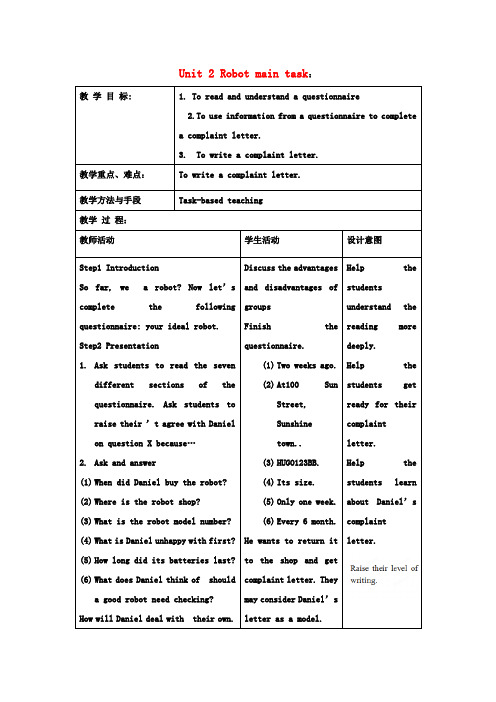
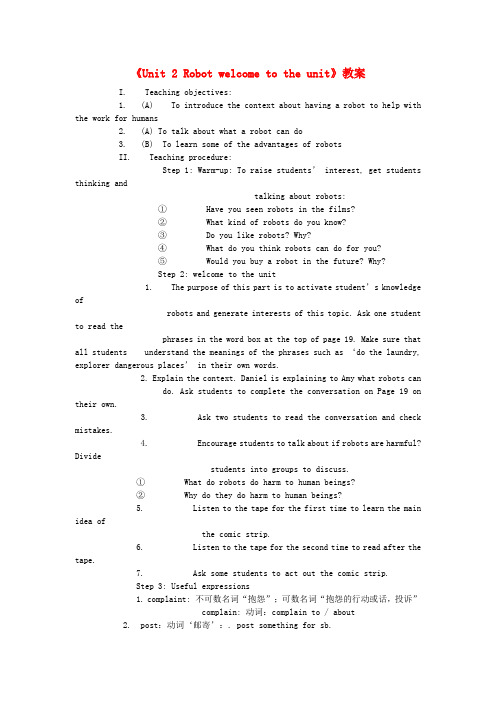
《Unit 2 Robot welcome to the unit》教案I. Teaching objectives:1. (A) To introduce the context about having a robot to help with the work for humans2. (A) To talk about what a robot can do3. (B) To learn some of the advantages of robotsII. Teaching procedure:Step 1: Warm-up: To raise students’ interest, get students thinking andtalking about robots:①Have you seen robots in the films?②What kind of robots do you know?③Do you like robots? Why?④What do you think robots can do for you?⑤Would you buy a robot in the future? Why?Step 2: welcome to the unit1. The purpose of this part is to activate student’s knowledge ofrobots and generate interests of this topic. Ask one student to read thephrases in the word box at the top of page 19. Make sure that all students understand the meanings of the phrases suc h as ‘do the laundry, explorer dangerous places’ in their own words.2. Explain the context. Daniel is explaining to Amy what robots cando. Ask students to complete the conversation on Page 19 on their own.3. Ask two students to read the conversation and check mistakes.4. Encourage students to talk about if robots are harmful? Dividestudents into groups to discuss.①What do robots do harm to human beings?②Why do they do harm to human beings?5. Listen to the tape for the first time to learn the main idea ofthe comic strip.6. Listen to the tape for the second time to read after the tape.7. Ask some students to act out the comic strip.Step 3: Useful expressions1. complaint: 不可数名词“抱怨”;可数名词“抱怨的行动或话,投诉”complain: 动词:complain to / about2. post:动词‘邮寄’:. post something for sb.III. Homework:1. Recite the useful vocabulary and comic strip.2. Complete some exercise.当堂检测(必做题)一、Millie 对文中短语掌握不好,请帮助她翻译,好吗?1.需要干某事2.为我寄封信3.一些推销员4.干洗衣服5.整理床铺 6.照看孩子7.洗碟子 8.熨烫衣服9.做饭 10.太空二、Millie 有些单词不会请你帮帮她.1.Please (记得)to give my best wishes to your teachers .2.I have to (清扫) the floor every day .3.Would you please (邮寄)this German letter for me ?4.Modern robots can do all the (家务活) 。

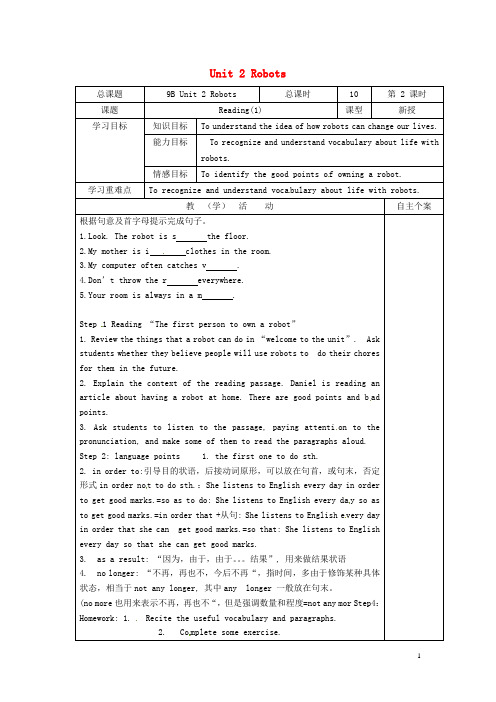
Unit 2 Robots总课题9B Unit 2 Robots 总课时10 第 2 课时课题Reading(1) 课型新授学习目标知识目标To understand the idea of how robots can change our lives.能力目标To recognize and understand vocabulary about life withrobots.情感目标To identify the good points o f owning a robot.学习重难点To recognize and understand voca bulary about life with robots.教(学)活动自主个案根据句意及首字母提示完成句子。
1.Look. The robot is s the floor.2.My mother is i clothes in the room.3.My computer often catches v .4.Don’t throw the r everywhere.5.Your room is always in a m .Step 1 Reading “The first person to own a robot”1. Review the things that a robot can do in “welcome to the unit”. Askstudents whether they believe people will use robots to do their choresfor them in the future.2. Explain the context of the reading passage. Daniel is reading anarticle about having a robot at home. There are good points and b adpoints.3. Ask students to listen to the passage, paying attenti on to the pronunciation, and make some of them to read the paragraphs aloud.Step 2: language points 1. the first one to do sth.2. in order to:引导目的状语,后接动词原形,可以放在句首,或句末,否定形式in order no t to do sth.:She listens to English every day in orderto get good marks.=so as to do: She listens to English every da y so asto get good marks.=in order that +从句: She listens to English e very dayin order that she can get good marks.=so that: She listens to Englishevery day so that she can get good marks.3. as a result: “因为,由于,由于。
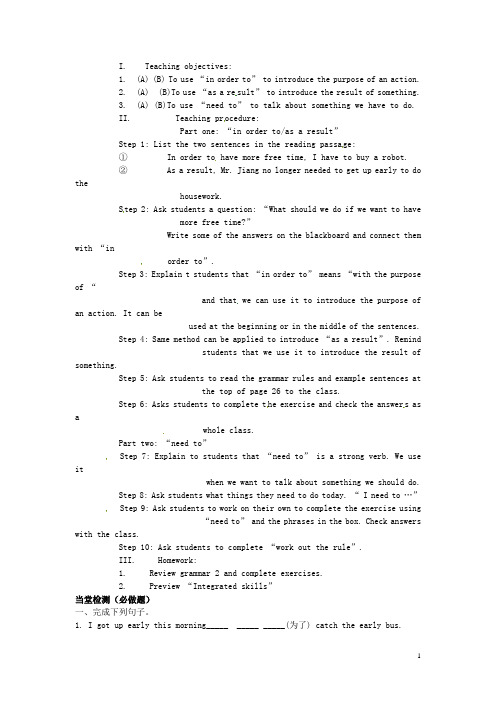
I. Teaching objectives:1. (A) (B) To use “in order to” to introduce the purpose of an action.2. (A) (B)To use “as a re sult” to introduce the result of something.3. (A) (B)To use “need to” to talk about something we have to d o.II. Teaching pr ocedure:Part one: “in order to/as a result”Step 1: List the two sentences in the reading passa ge:①In order to have more free time, I have to buy a robot.②As a result, Mr. Jiang no longer needed to get up early to do thehousework.S tep 2: Ask students a question: “What should we do if we want to havemore free time?”Write some of the answers on the blackboard and connect them wit h “inorder to”.Step 3: Explain t students that “in order to” means “with the purpose of “and that we can use it to introduce the purpose of an action. It can beused at the beginning or in the middle of the sentences.Step 4: Same method can be applied to introduce “as a result”. Remindstudents that we use it to introduce the result of something.Step 5: Ask students to read the grammar rules and example sentences atthe top of page 26 to the class.Step 6: Asks students to complete t he exercise and check the answer s as awhole class.Part two: “need to”Step 7: Explain to students that “need to” is a strong verb. We use itwhen we want to talk about something we should do.Step 8: Ask students what things they need to do today. “ I need to …”Step 9: Ask students to work on their own to complete the exercise using“need to” and the phrases in the box. Check answers with the class.Step 10: Ask students to complete “work out the rule”.III. Homework:1. Review grammar 2 and complete exercises.2. Preview “Integrated skills”当堂检测(必做题)一、完成下列句子。
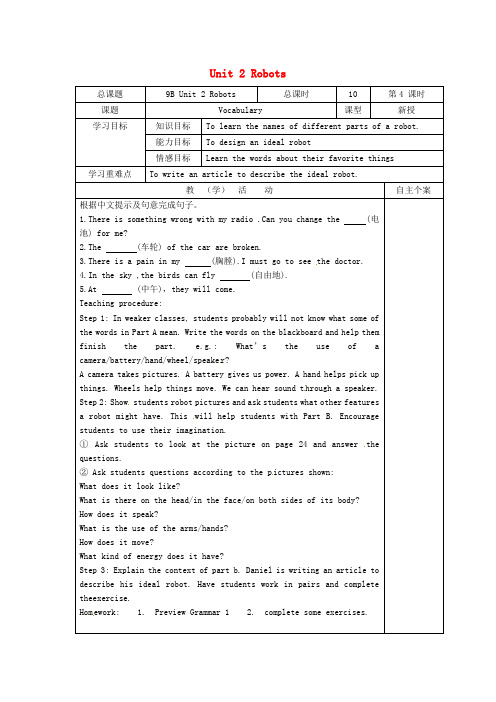
Unit 2 Robots总课题9B Unit 2 Robots 总课时10 第4 课时课题Vocabulary 课型新授学习目标知识目标To learn the names of different parts of a robot.能力目标To design an ideal robot情感目标Learn the words about their favorite things学习重难点To write an article to describe the ideal robot.教(学)活动自主个案根据中文提示及句意完成句子。
1.There is something wrong with my radio .Can you change the (电池) for me?2.The (车轮) of the car are broken.3.There is a pain in my (胸膛).I must go to see the doctor.4.In the sky ,the birds can fly (自由地).5.At (中午),they will come.Teaching procedure:Step 1: In weaker classes, students probably will not know what some ofthe words in Part A mean. Write the words on the blackboard and help themfinish the part. e.g.: What’s t he use of acamera/battery/hand/wheel/speake r?A camera takes pictures. A battery gives us power. A hand helps pick upthings. Wheels help things move. We can hear sound t hrough a speaker.Step 2: Show students robot pictures and ask students what other featuresa robot might have. This will help students with Part B. Encouragestudents to use their imagination.①Ask students to look at the picture on page 24 and answer the questions.② Ask students questions according to the p ictures shown:What does it look like?What is there on the head/in the face/on both sides of its body?How does it speak?What is the use of the arms/hands?How does it move?What kind of energy does it have?Step 3: Explain the context of part b. Daniel is writing an article todescribe his ideal robot. Have students work in pairs and complete theexercise.Hom ework: 1. Preview Grammar 1 2. complete some exercises.选择题()1.The robot can help Mum when there are dirty clothes.A. does the washingB. do the washingC. did the washingD. doing the washing()2.You to the party if you’re so busy.A. don’t need comeB. not need comingC. needn’t comeD. need not to come()3.They have to work at once, ?A. can theyB. can’t theyC. don’t theyD. haven’t they()4.I don’t know if he me if he free.A. will help ,will beB. helps, isC. will help, isD. helps, will be()5.The cars yesterday sell very well.A. what I sawB. sometimesC. some timeD. some times句型转换。
Unit 2 Robots总课题9B Unit 2 Robots 总课时10 第 7 课时课题Integrated skills 课型新授学习目标知识目标To extra information from a poster.能力目标To complete notes about a robot exhibition.情感目标Learn about the advantages of the robots.学习重难点To talk about what robots can do and give opinions about different types of robots.教(学)活动自主个案1. 商店在早上8点开门,晚上9点关门。
The shop ______ ______ 8 in the morning and _______ _______ 9 in theevening.2. 请尽快让我知道。
Please let me know ________ ________ _______ you can.3. 这个机器人是被设计来做家务的。
The robot ________ _________ _______ do the housework.4. 它会做任何种类的食物。
It can cook ________ _______ _______ food.5. 你将如何处理这笔钱。
What will you _________ _________ the money.Step 1: Ask students whether they have ever been to an exhibition centerand what exhibitions they have seen before.Step 2: Explain to students that they will not be able to find all theinformation they need to complete the notes in Part A1.Step 3: Tell students they can complete the notes by listening to the radio programme.①Listen to the tape for the first time to get its main idea.②Listen to it to find the necessary information they need.③Play the recording without stopping.④Ask students to give their own answers.⑤Check the answer with the class.⑥Play the recording again, all the way through, without stopping so thestudents can check their own answers.Step 4: Explain the context of part A3. Remind students they can referto the information on page 28 to fill in the blanks.Step 5: Ask students to work in pairs. They should read the conversationthrough once, swap roles and then read the conversation again.Step 6: Encourage students to make up their own conversations about robots.Listen to the students’as you walk around the classroom. Ask some pairsto present new conversations.Homework: 1. Recite the c onversation and complete some exercises.2. Preview pronunciation.选择填空。
Unit 2 Robot 一. 教学内容:Unit 2 Robot二. 教学目标:本单元词汇、短语和语言点知识【具体教学过程】(一)重点单词plaint n. 投诉;抱怨plain vi. 投诉;抱怨post vt. 邮寄laundry n. 洗衣物,洗衣店iron vt. 熨烫n. 熨斗;铁sweep vt. 打扫,清扫salesman n. 售货员;推销员everyday adj. 日常的,每天的dustbin n. 垃圾箱mess n. 混乱,杂乱spread vt. 使分布,展开,扩散smooth adj. 光滑的,平坦的rubbish n. 垃圾,废物dry adj. 干的vt. (使)变干;(把……)弄干nod v. 点either adv. /pron. 也; 二分之一copy n. 一本(份、册);副本vt. 抄写;复制;复印;模仿order n. 定单untidy adj. 不整洁的巩固练习:在下列句子中填上适当的词使句意完整。
1. Mr. Jiang is a _________________ and works in Moonlight Town.2. The robot ____________________ Mr. Jiang’s shirts yesterday.3. The robot would do the _______________________ for Mr. Jiang.4. A few weeks later the robot caught a ______________________.5. The robot threw the clean shirts in the ____________________.6. Sometimes the robot would ___________________ things over.7. Mr. Jiang found his flat in a ____________________.8. Having a robot was just too much _____________________.9. He ____________________ to me with a smile and said, “Hi!”.10. I haven’t been to Beijing, Tom hasn’t been to Beijing, ______________________.(二)重点短语:1. 在很多方面in many ways2. 为了做某事in order to do sth.3. 使蒋的生活更容易了make Jiang’s life much easier4. 为蒋烫衬衫iron Jiang’s shirts5. 为蒋准备午餐盒make a lunch box for Jiang6. 结果as a result7. 不再no longer/not any longer8. 需要早起need to get up early9. 在上班be at work10. 洗盘子wash the dishes11. 整理床make the bed12. 下班回家return home from work13. 跟新的一样干净be as clean as new14. 准备好be/get ready for15. 对……很满意be happy/satisfied with …16. 染上病毒catch a virus17. 把……返还回机器人商店return sth. to the robot shop18. 叫醒蒋wake Jiang up19. 四处转move around20. 撞翻东西knock things over(三)语言点知识:1. Mr. Jiang is the first person in Sunshine Town to own a robot. (L.2)①own 用作及物动词,表示“拥有”的意思他拥有这辆车。